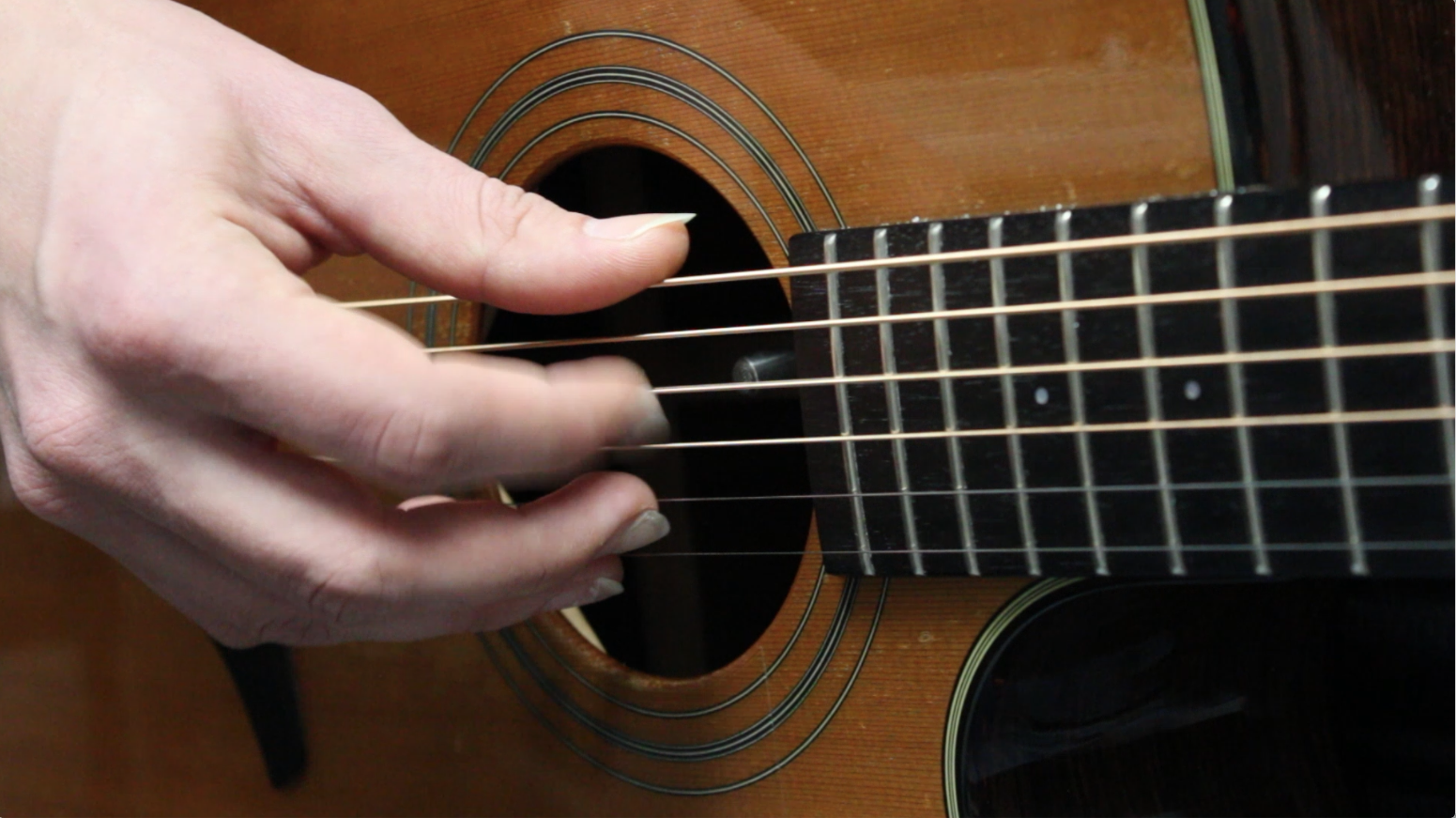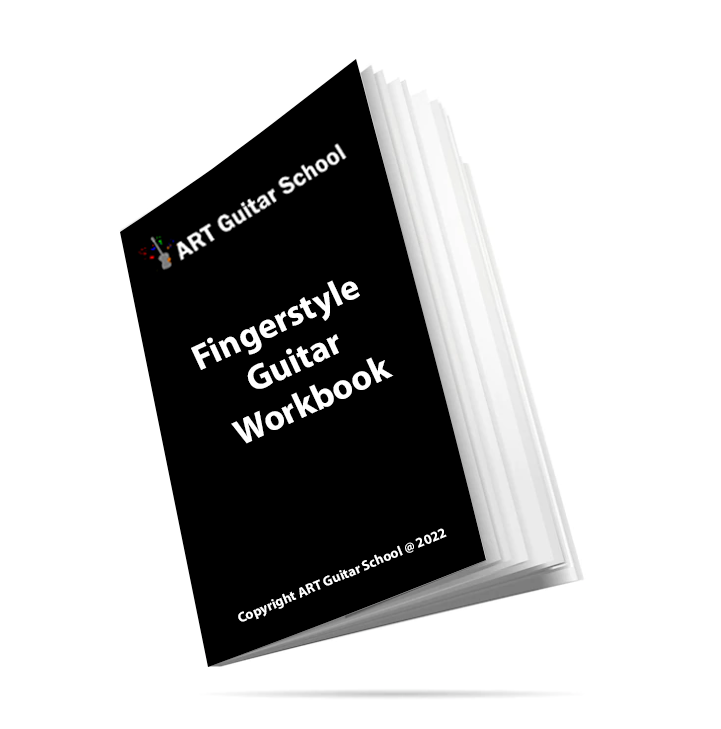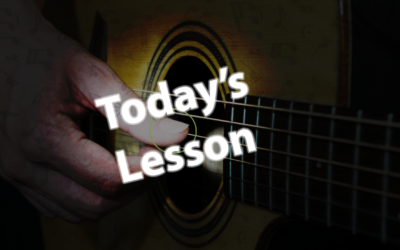FINGERPICKING KEY

The right hand:
P = Thumb
I = Index
M = Middle
A = Ring
Fingerpicking Pattern No. 1
This is the most essential fingerpicking pattern to start with. It requires no left hand chord or fretted notes. It is used in many popular fingerpicking songs and some songs are slight variations of this same pattern.
We have all open strings being plucked in sequential order. Each note is a quarter note in duration and will last exactly one second each if played at 60bpm.
Lets get to playing!
We will pluck each open string in order starting from the 6th string (Low E) and ending on the 1st (High E).
Step 1. Lets start with thumb (p) and pluck the 6th-4th string
Step 2. Pluck index (i), middle (m) and ring (a) on the 3rd-1st strings.

Here is a video demonstration of the finger picking pattern:
If you were having trouble please contact us and we will help you!
FOLLOW US ON
Get our FREE Fingerstyle Workbook!
RELATED BLOG POSTS
Introduction to Fingerstyle Guitar: A Beginner’s Guide
Fingerstyle guitar is a beautiful and expressive way to play the guitar, offering a vast range of textures, tones, and melodies. If you’re new to this technique, you might wonder where to start. In this guide, we’ll introduce you to the basics of fingerstyle guitar and provide some foundational knowledge to help you get started on your musical journey.
Fingerstyle guitar involves using your fingers (instead of a pick) to pluck the strings. This allows for greater control and flexibility, letting you produce intricate melodies, harmonies, and rhythms all at once. It’s a technique popular in many genres, from classical to folk to contemporary acoustic music.
Basic Fingerstyle Technique
At its core, fingerstyle guitar uses the thumb, index, middle, and sometimes the ring finger. The thumb typically handles the bass notes, while the other fingers take care of the higher-pitched strings. This creates a layered sound that can be both rhythmic and melodic at the same time.
Hand Positioning
A solid fingerstyle technique starts with proper hand positioning. Keep your hand relaxed, hovering over the strings. Your thumb should rest on the lower strings (E, A, D) and gently strum them, while your index, middle, and ring fingers handle the higher strings (G, B, e). The most important aspect is maintaining a relaxed posture to avoid tension, which could hinder your progress.
Practice Routine for Beginners
As a beginner, it’s crucial to develop finger independence and strength. Start by practicing simple patterns, alternating between the thumb and other fingers. For example, practice a basic alternating thumb pattern where your thumb plucks the bass notes (E, A, or D) and your other fingers alternate on the higher strings.
Choosing Your Guitar
For fingerstyle guitar, an acoustic guitar with a solid body and good tonal quality is ideal. Many guitarists prefer a larger body (like a dreadnought) for a fuller sound, but a smaller-bodied guitar like a concert or parlor can offer greater clarity for fingerstyle playing.
Final Thoughts
Fingerstyle guitar is incredibly rewarding and offers endless possibilities for creativity. By starting with the basics and practicing consistently, you’ll soon develop the skills to play a wide range of beautiful pieces. Stay patient, and remember that every expert started as a beginner.
Essential Fingerstyle Guitar Techniques for Beginners
If you’re eager to master fingerstyle guitar, understanding the essential techniques is crucial. Fingerstyle playing allows for intricate patterns and smooth transitions between melodies, rhythms, and bass lines. In this post, we will dive into the fundamental fingerstyle techniques that every beginner should know.
1. Thumb Placement and Bass Notes
The thumb plays a vital role in fingerstyle guitar. It’s responsible for plucking the bass strings (usually the low E, A, and D). Focus on developing a strong, steady thumb that can easily alternate between strings. Practice plucking the strings with even pressure, ensuring that your bass notes are consistent and clear.
2. Finger Positioning and Melody
Your index, middle, and ring fingers are responsible for the melody and accompaniment. The index finger usually plays the G string, the middle finger plays the B string, and the ring finger plays the high e string. Keep your fingers curved and relaxed, allowing you to create smooth, fluid movements. Avoid tensing up your hand or wrist.
3. Alternating Thumb and Finger
One of the most common techniques in fingerstyle is alternating the thumb with your fingers. This allows you to keep a consistent rhythm while playing both the bass and melody at the same time. Start by practicing simple patterns: thumb (bass note), index (higher string), thumb (next bass note), middle (next higher string). This alternating pattern will serve as the foundation for many fingerstyle pieces.
4. Arpeggios
Arpeggios involve breaking up a chord into individual notes that are plucked sequentially. Learning to play arpeggios is crucial in fingerstyle guitar because it allows for the smooth flow of chords and melodies. Practice basic arpeggio patterns, starting slow and gradually increasing your speed.
5. Fingerpicking Patterns
Fingerpicking patterns create a rhythmic foundation for many fingerstyle guitar pieces. Begin with simple patterns, such as the Travis picking pattern, which alternates between bass notes and melody notes. Once you’re comfortable with basic patterns, you can move on to more complex ones.
6. Hammer-ons and Pull-offs
Hammer-ons and pull-offs add expressiveness and fluidity to your playing. They involve using your fingers to “hammer” a note onto the fretboard or “pull” a note off without plucking the string again. These techniques are great for creating smooth transitions and enhancing the melody.
Conclusion
Mastering these essential fingerstyle techniques will give you a strong foundation to explore more complex pieces. Practice regularly, and remember that fingerstyle guitar is about patience and precision. Start with simple exercises and gradually challenge yourself with more intricate techniques.
Fingerstyle Techniques in Classical Guitar
Fingerstyle guitar is a fundamental aspect of classical guitar playing, distinguished by its intricate techniques and expressive capabilities. If you’re looking to deepen your understanding of fingerstyle techniques in classical guitar, here are some key methods and concepts to explore.
1. PIMA Technique: The PIMA technique—representing the thumb (P), index (I), middle (M), and ring (A) fingers—is foundational in classical fingerstyle. Each finger is assigned a specific role in plucking strings, enabling efficient and fluid playing. Practice exercises that emphasize the use of each finger independently before combining them.
2. Arpeggios: Classical guitar often incorporates arpeggios, where the notes of a chord are played sequentially rather than simultaneously. This technique creates a flowing, melodic sound. Practice common arpeggio patterns to develop your finger coordination and timing.
3. Free Stroke vs. Rest Stroke: Understanding the difference between free stroke and rest stroke is crucial. Free stroke allows the finger to pluck the string without any additional contact, producing a softer tone. In contrast, the rest stroke involves the finger coming to rest on the next string after plucking, creating a fuller sound. Experiment with both techniques to enhance your tonal variety.
4. Harmonics: Classical guitarists often use natural and artificial harmonics to add an ethereal quality to their music. Natural harmonics can be produced by lightly touching the string at specific frets, while artificial harmonics involve using the left hand to create a note while the right hand plucks the string. Incorporating harmonics into your playing can create beautiful, resonant tones.
5. Nail Care: For classical guitarists, nail care is essential. Well-maintained nails enhance tone production and articulation. Keep your nails at a comfortable length and shape them appropriately to ensure optimal performance.
6. Incorporating Dynamics: Classical music relies heavily on dynamics. Experiment with varying your finger strength and attack to create contrasts in volume. This adds emotional depth to your playing and helps convey the nuances of the music.
7. Mastering Classical Repertoire: To truly grasp fingerstyle techniques in classical guitar, study the works of renowned composers like Andrés Segovia, Francisco Tárrega, and Manuel de Falla. Their compositions provide invaluable insights into fingerstyle techniques and styles.
8. Practice Regularly: Consistent practice is key to mastering classical fingerstyle guitar. Set aside dedicated time to work on fingerstyle exercises, repertoire, and techniques. Focus on slow, deliberate practice to develop accuracy and control.
By delving into these fingerstyle techniques in classical guitar, you’ll enhance your playing and deepen your appreciation for this sophisticated style. As you progress, remember that the journey is just as important as the destination. Enjoy the process, and let your passion for classical guitar guide you.
The Origins of Fingerstyle Guitar: A Historical Overview
Fingerstyle guitar has a rich and diverse history that spans multiple cultures and musical genres. Understanding its origins provides valuable context for aspiring guitarists and enriches your appreciation for this expressive playing style.
The roots of fingerstyle guitar can be traced back to various ancient string instruments, including the lute and harp. These instruments were often plucked with fingers, laying the groundwork for modern fingerstyle techniques. In the 19th century, the guitar began to gain popularity as a solo instrument, particularly in Europe and Latin America.
In Spain, the flamenco guitar emerged, characterized by its intricate fingerpicking and percussive techniques. This style emphasized rapid strumming, intricate melodies, and the use of the thumb and fingers to produce a wide range of sounds. Flamenco guitarists became known for their passionate performances, influencing many musicians across the globe.
As the guitar gained popularity in the United States during the early 20th century, fingerstyle techniques began to blend with folk and blues traditions. Artists like Blind Lemon Jefferson and Mississippi John Hurt showcased the power of fingerpicking, combining melody and rhythm seamlessly in their performances. This era marked the birth of a distinctly American fingerstyle tradition that would influence countless musicians.
In the 1960s and 1970s, fingerstyle guitar experienced a resurgence, thanks to artists like Leo Kottke and John Fahey. These musicians expanded the boundaries of fingerstyle, incorporating elements of jazz, classical, and experimental music. Their innovative approaches encouraged a new generation of guitarists to explore fingerstyle techniques.
Today, fingerstyle guitar is celebrated across various genres, from classical to contemporary folk. The rise of social media platforms has further propelled its popularity, allowing guitarists to share their performances and connect with a global audience.
Understanding the historical context of fingerstyle guitar enriches your playing experience. As you explore this technique, consider the diverse influences that have shaped it over the years. Embrace the traditions while also innovating your unique style, and you’ll contribute to the ongoing evolution of fingerstyle guitar.




0 Comments